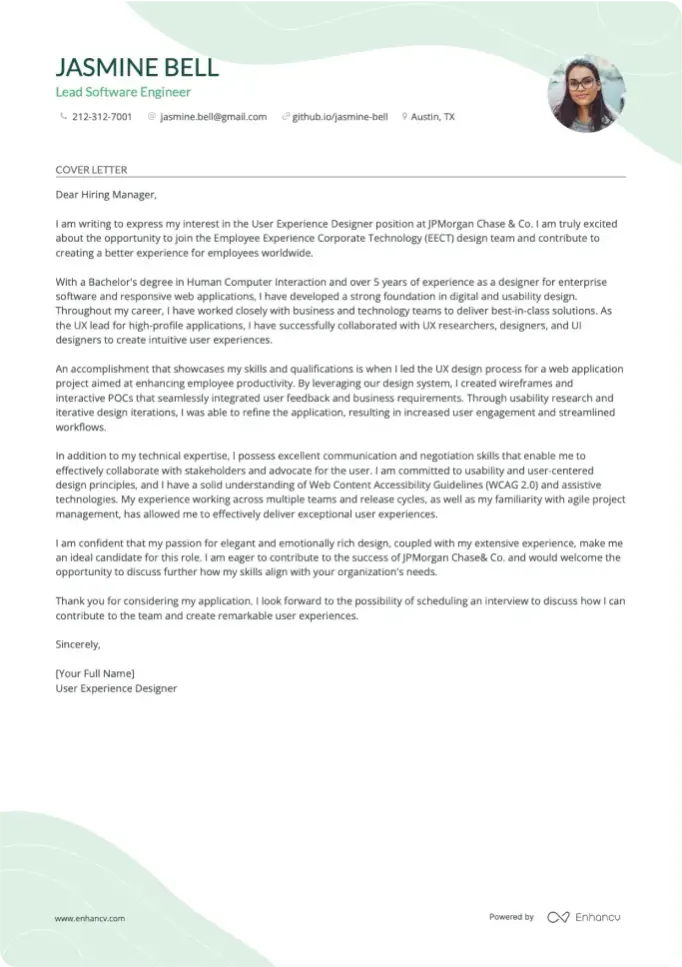Launching into the job market as a structural engineer, you've likely hit the snag of needing a standout cover letter. It's tempting to rehash your resume, but your cover letter is your chance to spotlight that one crowning achievement—the project that makes you swell with pride. This isn't the time for tired clichés; your story needs to shine with professional polish, all within the compact frame of a single page. Let's craft a cover letter that opens doors.
- Write a structural engineer cover letter that helps you stand out (and get the job);
- Understand how to start and end your structural engineer cover letter with the appropriate greeting;
- What to include in the body of your structural engineer cover letter to put your best foot forward;
- Your most important achievements - how to present them as part of your structural engineer cover letter.
And if you want to make your life even easier, simply drag and drop your structural engineer resume into Enhancv's AI cover letter generator, and it will write your cover letter for you in just a few moments.
If the structural engineer isn't exactly the one you're looking for we have a plethora of cover letter examples for jobs like this one:
Drop your resume here or choose a file.
PDF & DOCX only. Max 2MB file size.
Structural engineer cover letter example
JOHN DOE
San Francisco, CA
+1-(234)-555-1234
help@enhancv.com
- Emphasizing relevant project experience, such as leading a seismic retrofit, showcases the candidate's direct knowledge and technical skills pertinent to high-stakes structural engineering projects.
- Highlighting leadership and managerial skills conveys the candidate's ability to handle complex projects and lead teams effectively, which is vital for project-based work in engineering.
- Expressing familiarity and admiration for the hiring firm's work and a strong desire to contribute to its success demonstrates the candidate's genuine interest and potential cultural fit within the company.
- Including quantifiable achievements, like enhancing safety by a specific percentage or managing a portfolio valued at a certain amount, provides concrete evidence of past success and competence.
The must-have sections and format of your structural engineer cover letter
When writing your structural engineer cover letter, keep in mind that it'll only be read by the recruiters and not the Applicant Tracker System (or software used to assess your profile). That's why you should structure your content with a/an:
- Header (apart from your contact information, include your name, the role you're applying for, and the date);
- Personalized salutation;
- Opening paragraph to win the recruiters over;
- Middle paragraph with key details;
- Closing that starts from clichés;
- Sign off (that's not mandatory).
Industry standards dictate your paragraphs to be single-spaced and to wrap your content in a one-inch margin. Designing your structural engineer cover letter, refer to one of our templates, which automatically takes care of the spacing and margins.
Choose the same font for your structural engineer cover letter as you did for your resume: the likes of Lato and Bitter would help you to stand out in a sea of cover letters in Arial or Times New Roman.
Export your whole structural engineer cover letter from our builder in PDF to keep the same formatting and image quality.
Why worry about your cover letter? Create one instantly using our free cover letter generator.
The top sections on a structural engineer cover letter
- Header: Include your contact information, date, and the employer's contact details to ensure the cover letter appears professional and provides easy reference for follow-up.
- Opening Greeting: Address the hiring manager or the recruitment team by name, which demonstrates attention to detail and personalization, aspects that are pivotal in structural engineering projects.
- Introduction: Briefly mention your relevant experience, qualifications, and your enthusiasm for the role of structural engineer, showcasing your understanding of the position's significance in ensuring safety and design integrity.
- Professional Experience and Achievements: Highlight specific past projects, problem-solving skills, and accomplishments like successful load analysis or innovation in structural design, to demonstrate your capability and fit for the role.
- Closing and Call to Action: Politely express your desire for an interview or further discussion, and assert your readiness to contribute to the company's success with your expertise in structural engineering.
Key qualities recruiters search for in a candidate’s cover letter
Proficiency in structural analysis and design software: Recruiters look for structural engineers who are adept with industry-standard tools such as AutoCAD, Revit, STAAD.Pro, or SAP2000, as this expertise is critical for creating accurate structural designs and simulations.
Strong grasp of building codes and regulations: Structural engineers must ensure their designs comply with local, state, and national building codes, and recruiters value candidates who are knowledgeable about these regulations to avoid legal issues and ensure safety.
Experience with different materials and construction methods: Recruiters prioritize candidates who have hands-on experience with a variety of materials like steel, concrete, wood, and composites, as well as familiarity with different construction techniques, reflecting versatility and adaptability in their work.
Excellent analytical and problem-solving skills: Structural engineering involves complex calculations and problem-solving. Recruiters look for candidates who can foresee potential issues in design and construction and address them proactively.
Effective communication and teamwork: Structural engineers must communicate technical information clearly to non-engineers and work collaboratively with architects, contractors, and other engineers. Recruiters value candidates who can demonstrate strong interpersonal and team-playing skills.
Proven track record of project management: Many structural engineering roles involve project oversight, and recruiters seek candidates with experience in managing timelines, budgets, and multidisciplinary teams to ensure successful project completion.
What greeting should you use in your structural engineer cover letter salutation
A simple "Hello" or "Hey" just won't work.
With your structural engineer cover letter salutation, you set the tone of the whole communication.
You should thus address the hiring managers by using their first (or last name) in your greeting.
But how do you find out who's recruiting for the role?
The easiest way is to look up the role on LinkedIn or the corporate website.
Alternatively, you could also contact the organization via social media or email, for more information.
Unable to still obtain the recruiter's name?
Don't go down the "To whom it may concern path". Instead, start your cover letter with a "Dear HR team".
List of salutations you can use
- Dear Hiring Manager,
- Dear [Employer's Name],
- Dear Mr./Ms. [Last Name],
- Dear [Company Name] Recruiter,
- Dear [Department] Team,
- Dear Hiring Committee,
The structural engineer cover letter intro: aligning your interest with the company culture
You only have one chance at making a memorable first impression on recruiters with your structural engineer cover letter.
Structure your introduction to be precise and to include no more than two sentences.
Here are some ideas on how to write a job-winning structural engineer cover letter introduction:
- get creative - show off your personality from the get-go (if this aligns with the company culture);
- focus on your motivation - be specific when you say what gets you excited about this opportunity.
What to write in the body of your structural engineer cover letter
Now that you've got your intro covered, here comes the heart and soul of your structural engineer cover letter.
It's time to write the middle or body paragraphs. This is the space where you talk about your relevant talent in terms of hard skills (or technologies) and soft (or people and communication) skills.
Keep in mind that the cover letter has a different purpose from your structural engineer resume.
Yes, you still have to be able to show recruiters what makes your experience unique (and applicable) to the role.
But, instead of just listing skills, aim to tell a story of your one, greatest accomplishment.
Select your achievement that:
- covers job-crucial skills;
- can be measured with tangible metrics;
- shows you in the best light.
Use the next three to six paragraphs to detail what this success has taught you, and also to sell your profile.
Two ideas on how to end the final paragraph of your structural engineer cover letter
Closing your structural engineer cover letter, you want to leave a memorable impression on recruiters, that you're a responsible professional.
End your cover letter with how you envision your growth, as part of the company. Make realistic promises on what you plan to achieve, potentially, in the next six months to a year.
Before your signature, you could also signal hiring managers that you're available for the next steps. Or, a follow-up call, during which you could further clarify your experience or professional value.
What could you write about in your structural engineer cover letter when you have no experience
Candidates with zero professional experience often struggle to write their structural engineer cover letter.
You may lack experience, but your application could still be impressive when you focus on your strengths.
Consider your most relevant talents (and/or one achievement) that align with the role and help you stand out.
Perhaps you spent every summer volunteering at your local dog pound - think of the job-relevant skills this experience taught you.
Sharing your tangible career goals is another good strategy to stand out.
Key takeaways
Writing your structural engineer cover letter doesn't need to turn into an endless quest, but instead:
- Create an individual structural engineer cover letter for each role you apply to, based on job criteria (use our builder to transform your resume into a cover letter, which you could edit to match the job);
- Stick with the same font you've used in your resume (e.g. Raleway) and ensure your structural engineer cover letter is single-spaced and has a one-inch margin all around;
- Introduce your enthusiasm for the role or the company at the beginning of your structural engineer cover letter to make a good first impression;
- Align what matters most to the company by selecting just one achievement from your experience, that has taught you valuable skills and knowledge for the job;
- End your structural engineer cover letter like any good story - with a promise for greatness or follow-up for an interview.




